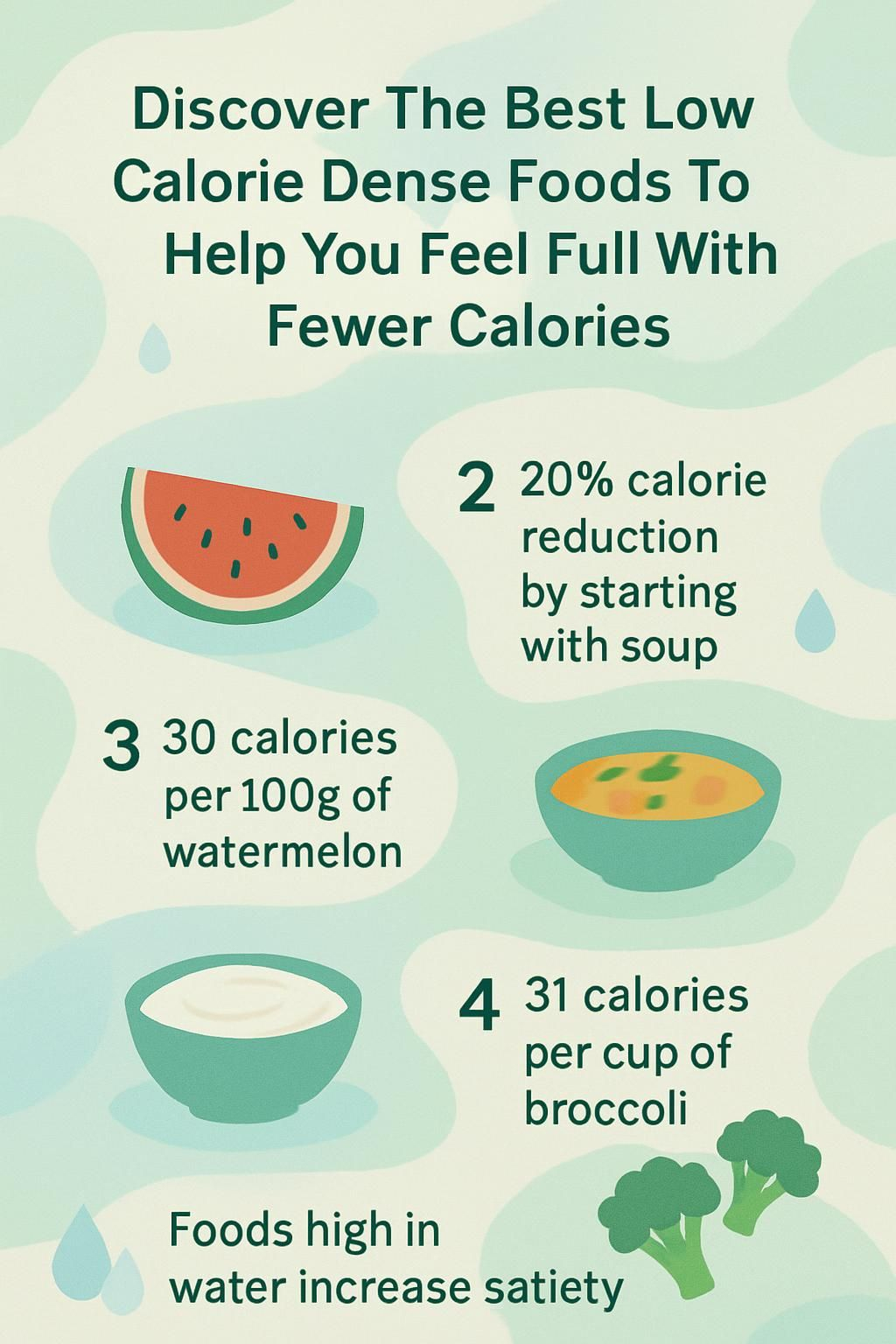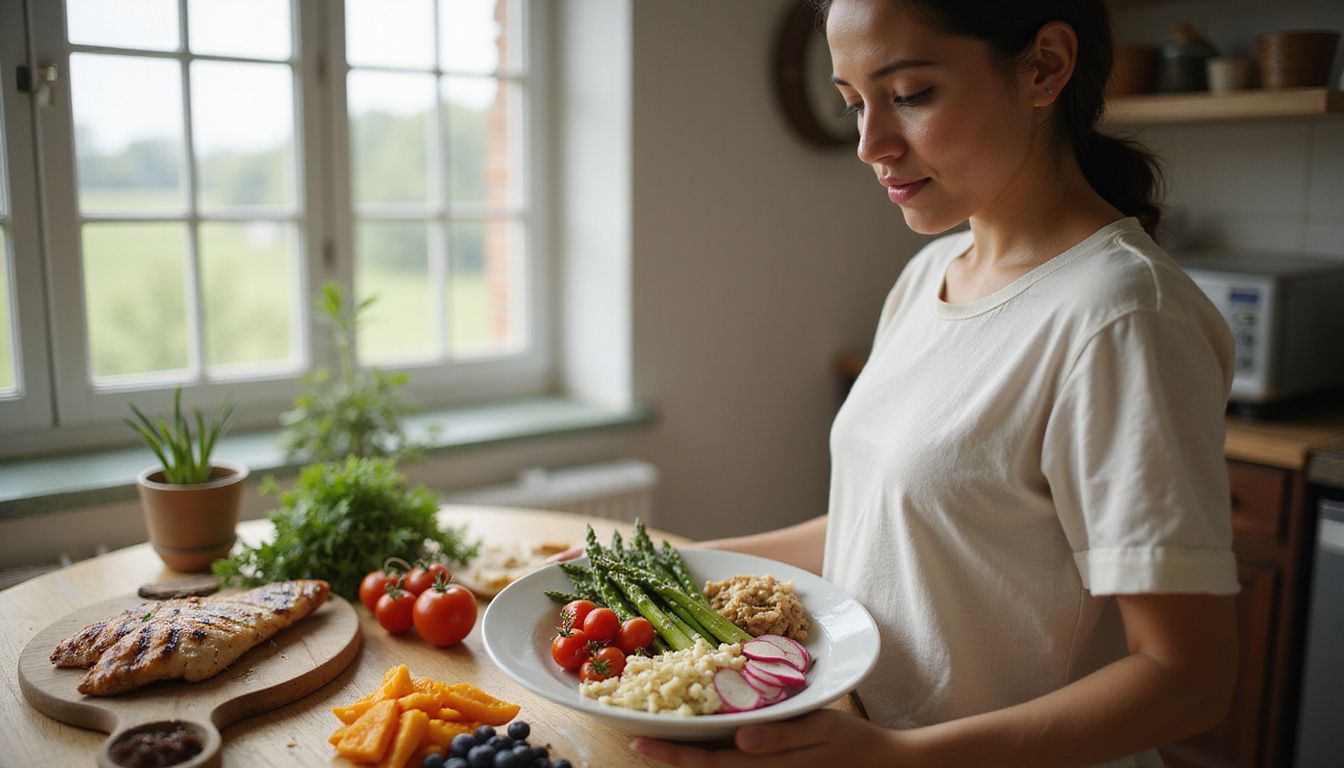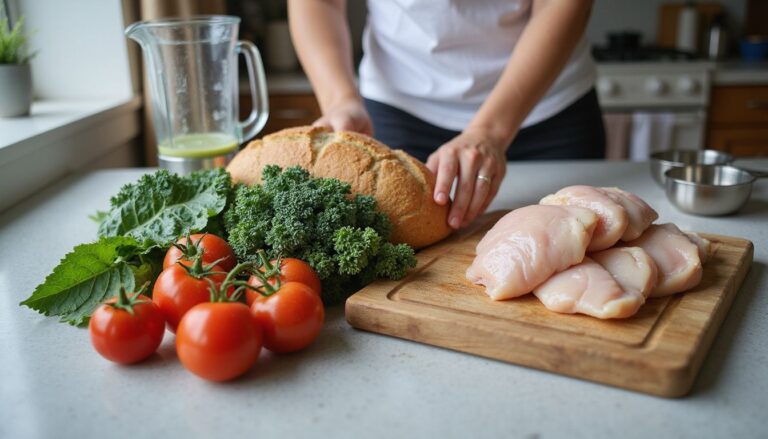Discover The Best Low Calorie Dense Foods To Help You Feel Full With Fewer Calories
Our Nutrition Assistant AI Suite will transform your body. You will lose fat, get toned, and build muscle. Gain confidence and optimal health.
Cutting calories can leave you hungry. Low calorie foods with high water and fiber help you feel full with fewer calories, so you can stick to your goals without feeling deprived.
This guide shows you how to choose nutrient-dense foods that satisfy, support a healthy diet, and deliver key vitamins and minerals without a big calorie load.
Explore smart picks for meals and snacks that keep you satisfied and on track.
Key Takeaways
- Low calorie dense foods like watermelon, broccoli, and air-popped popcorn offer volume for very few calories, helping you feel full on less energy.
- High water and fiber choices, such as spinach, apples, grapefruit, and legumes, increase food volume and boost satiety with little fat or added sugar.
- Swapping high-calorie snacks for Greek yogurt, low-fat cottage cheese, or broth-based soups can lower daily intake while preserving important nutrients.
- The Dietary Guidelines for Americans (2020-2025) and the Mayo Clinic Healthy Weight Pyramid favor fruits, vegetables, lean proteins, whole grains, and legumes for weight control.
- Clinical studies show that starting a meal with broth-based soup can reduce total calories eaten by about 20 percent.

What Are Low Calorie Dense Foods?

Low calorie dense foods give you more food for fewer calories. Bigger portions with less energy make it easier to hit your calorie goals and still feel satisfied.
What does calorie density mean?
Calorie density is the number of calories in a given weight or volume of food. High-density foods, such as French fries or raisins, pack many calories into small portions. For example, about 1 cup of raisins has roughly 480 calories, while 1 cup of grapes has about 104 calories.
Portion size and food type drive total intake. Water, fiber, and fat content change how many calories you get per bite. High water and fiber foods, like spinach, let you eat more food with fewer calories.
Key idea:
The more water and fiber per calorie a food has, the larger it looks on your plate without adding many calories.
Once you see this difference, it becomes clear why some foods keep you full longer while others burn through your daily calorie budget fast.
How do low calorie dense foods differ from high calorie dense foods?
Low calorie dense foods have fewer calories in larger portions. Fruits, vegetables, legumes, and lean proteins tend to be lower in calories per cup because they hold more water and fiber. You get more volume, which helps you stay full longer.
High calorie dense foods, such as candy, butter, fried snacks, and shortening, deliver a lot of energy in small servings because of high fat or sugar. They add up quickly, which makes it easy to overshoot your calorie goals.
Swapping chips for air-popped popcorn or adding leafy greens to plates often increases satisfaction without hitting 100 calories quickly. Choosing lower density foods supports the Dietary Guidelines for Americans and helps you enjoy bigger, more satisfying meals.
Benefits of Low Calorie Dense Foods
These foods let you eat larger portions while keeping calories in check. That helps you manage hunger and maintain a healthy weight over time.
How do low calorie dense foods help you feel full with fewer calories?
Low calorie dense foods allow bigger portions that digest more slowly. One cup of air-popped popcorn has about 30 calories yet brings fiber that helps curb hunger. Half a grapefruit contains about 64 calories and is mostly water, which helps you feel full fast.
Water-rich foods like watermelon, cucumbers, or raw carrots add volume in your stomach, which signals fullness to your brain. Replacing fries with spinach, strawberries, or bell peppers gives you far more food on your plate for the same calorie cost.
This strategy limits hunger and makes a healthy weight more achievable.
Can these foods support sustainable weight loss?
Yes. Low calorie dense foods support steady fat loss by controlling hunger with fewer calories. The Mayo Clinic Healthy Weight Pyramid and the Dietary Guidelines for Americans recommend these choices for long-term success.
Research shows higher fruit and vegetable intake is linked to meaningful weight changes in adults. Replacing high-calorie snacks with options like air-popped popcorn or low-fat cottage cheese reduces intake while keeping nutrients strong.
High fiber and high water foods help you feel satisfied, so portion control becomes easier and cravings drop. Over time, that supports sustainable weight loss.
Choose low calorie dense foods to eat more, feel full longer, and move steadily toward your weight goals.
What essential nutrients and vitamins do they provide?
Fruits and vegetables deliver vitamins, minerals, antioxidants, and fiber. Oranges supply vitamin C for immune function. Spinach provides iron for healthy blood.
Broccoli offers vitamins A and K plus potassium for heart health. Greek yogurt and cottage cheese supply protein, calcium, and vitamin D for bones and muscles.
Lean meats, like skinless chicken breast, provide complete protein for growth and repair with little fat. Whole grains, such as oatmeal, bring B vitamins and minerals like zinc. Legumes, including lentils, add plant protein, fiber, and folate for cell function.
Key Characteristics of Low Calorie Dense Foods
These foods help you manage hunger while in a calorie deficit. Many are rich in fiber and protein, which help with weight loss goals.
High water content
Fruits and vegetables offer high water content, which boosts volume without adding many calories. Half a grapefruit is about 90 percent water and only 64 calories. A medium carrot is about 88 percent water with around 25 calories.
Broth-based soups are also high in water and low in calories. Meals built with water-rich foods help you feel full longer, so reducing total intake feels simpler.
Salads with tomatoes, cucumbers, and leafy greens, paired with a cup of broth-based soup, can keep you satisfied for hours.
Rich in fiber
High fiber foods digest more slowly and promote long-lasting fullness. The Academy of Nutrition and Dietetics notes that a higher fiber intake supports weight management and reduces hunger.
One cup of air-popped popcorn has about 30 calories and contains fiber. Whole grains like oatmeal and brown rice provide more fiber than refined grains such as white bread or regular pasta. Fiber helps keep blood sugar steady and supports healthy digestion.
Low in fats and sugars
Low calorie dense foods are usually lower in fats and added sugars. Foods heavy in fat, like butter and shortening, have high energy density and can drive weight gain if eaten often.
Focus on foods with little added sugar. Fresh fruits like apples or berries offer natural sweetness with far fewer calories than most desserts or sweet drinks.
Limit saturated and trans fats to reduce heart risk. Choose small amounts of healthy fats, such as those from nuts, seeds, and oils. Round out plates with vegetables, lean meats like skinless chicken breast, egg whites, Greek yogurt, low-fat cottage cheese, and legumes such as lentils or chickpeas that bring both protein and fiber with minimal added oil or sugar.
Center meals on foods that are naturally lower in fat and added sweeteners. You get more nutrition per calorie compared with many processed snacks on store shelves today.
Best Low Calorie Dense Fruits
Fruits like watermelon, strawberries, grapefruit, blackberries, and apples are high in fiber and water. They deliver vitamins with fewer calories and help you avoid overeating.
Why is watermelon a good low calorie dense fruit?
Watermelon is about 92 percent water and only 30 calories per 100 grams. You can enjoy a generous serving without a big calorie hit.
It is very low in fat and supplies vitamins A and C. Its natural sweetness helps satisfy sugar cravings without added sugars. Antioxidants in watermelon support cell health. Because it has a high volume per calorie, it helps you stay full longer compared with many higher calorie fruits.
What makes strawberries a healthy choice?
Strawberries pack nutrition into 25 calories per half cup. You get vitamin C, fiber, and antioxidants in each serving. Their high water content helps you feel full on fewer calories.
They are low in fat, cholesterol, and sodium. Add them to yogurt or cereal, or enjoy them as a light, sweet snack.
How does grapefruit support fullness with fewer calories?
Half a grapefruit has about 64 calories and is more than 90 percent water. That combination boosts fullness without many calories. Its fiber slows digestion and helps control hunger, while vitamin C supports your immune system.
Grapefruit may also support heart health by helping manage cholesterol. Add slices to breakfast or salads for a bright flavor and lasting satisfaction.
What benefits do blackberries offer?
A half cup of blackberries has about 32 calories. They deliver fiber and vitamin C, which support fullness and immune health. Blackberries also contain antioxidants that protect cells.
They are low in fat and cholesterol and support healthy digestion. Use them for snacks or simple desserts that align with weight loss goals.
Why include apples in a low calorie dense diet?
Apples have high water content and are rich in fiber. A small apple has roughly 80 calories and helps you feel full between meals. They are low in fat and sodium, which supports heart health.
Apples also provide vitamin C. Enjoy them as a snack or slice them into salads and cereals for extra crunch.
Best Low Calorie Dense Vegetables
Choosing low calorie dense vegetables helps control hunger, supports nutrient intake, and keeps calories modest.
What makes broccoli a top low calorie dense vegetable?
One cup of chopped raw broccoli has about 31 calories. It brings fiber for fullness and vitamins C and K for immune and bone health. It is low in fat and contains no cholesterol.
Broccoli also offers antioxidants. Enjoy it raw or cooked, in salads, stir-fries, soups, or as a side dish.
How does spinach contribute to satiety?
Spinach is low in calories and high in water and fiber. You can eat very large portions for a small calorie cost, which makes meals look generous without adding much energy.
It provides vitamins A, C, and K plus folate and iron. Fiber supports digestion and fullness. Add spinach to omelets, pasta, soups, and sandwiches to boost nutrients without extra fat or sugar.
Why choose zucchini for low calorie density?
Raw zucchini has about 17 calories per cup and a high water content. It supplies vitamin C, potassium, and fiber, which support fullness without adding many calories.
Use spiralized zucchini instead of noodles or add chopped zucchini to stir-fries. Its mild flavor blends well with many dishes while keeping calorie density low.
What are the benefits of bell peppers?
One medium bell pepper provides more than 150 percent of the daily value for vitamin C. You also get vitamin A and fiber for eye health and digestion. The bright colors signal beneficial plant compounds that support cell protection.
Bell peppers are low in calories and high in water, which makes them great for salads and snacks. Slice them for dips like hummus or roast them for extra flavor.
How does cauliflower fit into a low calorie dense diet?
One cup of raw chopped cauliflower has about 27 calories. It supplies fiber and vitamins, including vitamin C and several B vitamins. It is water-rich, which supports fullness with few carbs or fats.
Swap rice or potatoes for cauliflower to lower calorie density and keep a hearty texture. Roast, steam, or blend it into soups for variety.
High-Protein, Low Calorie Dense Foods
High protein foods help you stay satisfied and maintain muscle. These options keep calories modest while bringing strong nutrition.
Are eggs a good source of protein with low calories?
Eggs provide high-quality protein and important nutrients. One large egg has about 70 calories and roughly 6 grams of protein. An egg white has about 17 calories with over 3 grams of protein and no fat.
Add eggs to salads or pair with vegetables for a balanced, filling meal. Eggs also offer vitamins like B12 and choline, which support brain function.
How does Greek yogurt help with fullness?
Greek yogurt is a rich source of protein, which slows digestion and curbs hunger. A plain low-fat Greek yogurt has about 73 calories per 100 grams and feels creamy.
It also delivers calcium for bones and probiotics that may support gut health. Add berries or a sprinkle of nuts for flavor, fiber, and a little healthy fat.
Why include cottage cheese in your diet?
Low-fat cottage cheese gives you a high-protein, low-calorie option. A half cup provides about 80 calories along with protein and calcium. It supports muscle maintenance and helps you feel full longer.
Enjoy it alone, with fruit like berries, or with tomatoes and pepper on whole grain toast.
What lean meats are best for low calorie density?
Skinless chicken breast is high in protein and relatively low in calories. Turkey breast is also a strong choice. Pork tenderloin is leaner than many other pork cuts while still offering plenty of protein.
Use portion control and pair lean meats with vegetables. This keeps meals satisfying without excess fat or sugar.
How do legumes like lentils and chickpeas help?
Lentils and chickpeas are high in both protein and fiber. About 100 grams of cooked lentils has roughly 114 calories. The same amount of cooked chickpeas has about 164 calories.
They bring iron, magnesium, vitamin B6, and potassium. Add them to soups, salads, or mains. They make strong plant-based alternatives to higher fat meats.
Additional Low Calorie Dense Options
These choices add volume and nutrients to meals and snacks without a big calorie cost.
Why choose broth-based soups?
Broth-based soups are high in water and low in calorie density, which gives you more volume for fewer calories. Adding vegetables like carrots, spinach, or edamame raises fiber and vitamins while keeping calories low.
Lean proteins, such as chicken or beans, boost fullness. Clinical research shows that starting a meal with a broth-based soup can reduce total calories eaten by about 20 percent.
For extra texture, add modest amounts of whole grains like barley or wild rice.
Is air-popped popcorn a healthy low calorie snack?
Air-popped popcorn helps manage hunger with little energy. One cup has about 30 calories and comes with whole grain fiber.
It keeps fat and sugars low because it is made with hot air rather than oil. You can eat a larger portion for the same calories as many chips. Keep an eye on serving sizes since several cups will add up.
What benefits do chia seeds provide?
Chia seeds pack fiber, protein, and omega-3 fatty acids, which are healthy fats that support the heart. One ounce has nearly 11 grams of fiber, which helps slow digestion and increase fullness. They absorb water and expand, so they add volume in your stomach.
Sprinkle them on yogurt or oatmeal or blend into smoothies. They also provide calcium, magnesium, and phosphorus.
How does oatmeal fit into a low calorie dense diet?
Cooked oatmeal has about 71 calories per 100 grams. It is high in fiber and water, so it fills you up while staying within calorie goals. As a whole grain, it also supplies vitamins and minerals that support energy and bone health.
Top with berries or a small spoon of chia seeds to add flavor and nutrients with limited calories. Many people find a morning bowl keeps hunger away until lunch.
How to Incorporate Low Calorie Dense Foods into Your Diet
Add berries, blackberries, and oranges to meals and snacks for better satiety. Grill or bake chicken with garlic and serve mineral-rich vegetables with whole grain toast for more nutrition.
How can you create balanced meals with these foods?
Balanced meals help you feel full while keeping calories low. Aim to include fruits, vegetables, lean protein, whole grains, and healthy fats.
- Start breakfast with nonfat yogurt, papaya, kiwi, and a small portion of walnuts to get fiber, vitamins, and healthy fats within a modest calorie range.
- Pack lunch in a whole wheat pita with dark leafy lettuce, pepper slices, grape tomatoes, edamame, and a spoon of sunflower seeds for protein and minerals.
- Serve broiled wild salmon with a light yogurt sauce at dinner. Add cooked barley, lentils, and steamed baby bok choy for volume and variety.
- Use olive oil mixed with balsamic vinegar instead of creamy dressings to add flavor and heart-healthy fats.
- Choose unsweetened drinks like water, black coffee, or skim milk in place of soda or juice to cut empty calories.
- Plan snacks that cover food groups, for example berries or apples with Greek yogurt for extra protein.
- Grill chicken or halibut as main dishes to bring about 28 grams of protein per serving without extra fat from frying.
What are good fruit and vegetable snack ideas?
Produce-based snacks manage hunger and deliver vitamins, minerals, and fiber. Keep them simple and ready to eat.
- Raw vegetables like broccoli, bell peppers, salad greens, or carrots provide a crunchy, slow-to-eat snack.
- Fresh or frozen fruits such as strawberries, blackberries, kiwi, and grapefruit supply vitamin C and fiber.
- Stir blueberries into cereal or Greek yogurt for a colorful, filling snack.
- Top toast with mango or peach slices plus peanut butter to blend protein with natural sweetness.
- Add mandarin oranges to leafy salads for extra vitamin C and bright flavor.
- Pair celery or carrots with low-fat yogurt or hummus for a protein-rich dip.
- Slice apples and serve with cottage cheese for a high-protein, mineral-rich snack.
- Mix blackberries into oatmeal to raise fiber and antioxidants.
- Dust apple slices with cinnamon for a dessert-like taste with almost no extra calories.
How do you replace high calorie dense foods with low calorie dense options?
Simple swaps each day can lower calorie intake without leaving you hungry. Choose options that add water and fiber to increase volume.
- Trade a small order of fries for a large serving of spinach, strawberries, and apple for similar calories but far more food volume.
- Pick broth-based soups over cream-based versions to cut fat and reduce calorie density.
- Use small amounts of olive, flaxseed, or safflower oil instead of butter or shortening to lower saturated fat.
- Switch from refined grains to whole grain breads, cereals, and pastas to add fiber and minerals like magnesium and iron.
- Drink water or eat an orange instead of fruit juice to avoid extra sugars and increase fiber.
- Choose fresh or frozen fruits instead of dried fruits to get more water and fewer concentrated calories per serving.
- Limit sweets by choosing dark chocolate or whole wheat cookies in modest portions to reduce sugar spikes.
- Bring high-protein Greek yogurt or cottage cheese instead of chips, since protein helps you feel full.
- Snack on air-popped popcorn instead of potato chips. Three cups have roughly 100 calories and offer whole grain fiber.
- Make oatmeal with nuts or berries in place of sugary cereals to boost fiber and morning fullness.
These swaps often lead to steadier energy and fewer cravings during long days.
Tips for Maximizing Satiety with Fewer Calories
Pair smart nutrients, hydrate during meals, and eat with attention. These habits make low calorie choices work harder for you.
How to combine protein and fiber-rich foods for fullness?
Combine protein with fiber to stay full longer. Add lentils, at about 114 calories per 100 grams cooked, to whole grains like barley, at about 123 calories per 100 grams cooked, for slow-digesting meals.
Mix Greek yogurt with blackberries or bran flakes. Top oatmeal with chia seeds or orange slices. Toss beans, peas, or edamame into salads.
Serve lean meats or fish with roasted vegetables. These combinations support steady blood sugar and longer satiety.
Why should you drink water with meals?
Water increases the total volume in your stomach, which can trigger fullness signals. People who drink water before or during meals often eat fewer calories.
Water has zero calories and supports digestion and metabolism. Choosing water instead of sugary drinks reduces added sugar while managing hunger more effectively.
Pair hydration with water-rich foods like oranges or grapefruit to further enhance fullness.
What is mindful eating and how does it help?
Mindful eating means paying attention to hunger signals, fullness, and the taste of each bite. This helps you choose better portions and avoid eating from boredom or stress.
Eating slowly gives your body time to signal fullness, which usually takes about 20 minutes. Reducing distractions at meals can help you notice satisfaction sooner.
People who practice mindful eating tend to maintain healthier patterns over time, which supports weight management.
Conclusion
Choosing low calorie dense foods helps you feel full with fewer calories. Fruits like blackberries, apples, and oranges deliver fiber and vitamins. Vegetables such as broccoli and cauliflower add volume and nutrients without many calories. Lean protein and whole grains round out meals so you get the minerals your body needs.
This information is for general education, not medical advice. If you have a chronic condition or specific nutrition needs, speak with a registered dietitian or your healthcare provider.
Build your plates with these foods and simple swaps. You will control hunger, support healthy weight, and make progress that lasts.
References: Dietary Guidelines for Americans 2020-2025; Mayo Clinic Healthy Weight Pyramid; Dreher ML et al., research on fruits and vegetables and weight management; evidence from clinical studies on soup preload and energy intake.
FAQs
1. Which fruits are low calorie dense and help reduce hunger?
Oranges and blackberries are both low in calories but high in water and fiber. These qualities make them effective for controlling hunger, as supported by research on satiety and energy density (Rolls et al., 2005).
2. How do nuts support feeling full with fewer calories?
Nuts such as almonds or walnuts contain healthy fats, protein, and minerals like magnesium. While they have more calories per serving than some fruits, their nutrient content helps curb appetite when eaten in small amounts (Mattes et al., 2008).
3. What role do minerals play in choosing filling foods?
Minerals such as potassium found in oranges or magnesium present in nuts aid metabolism and muscle function. Including mineral-rich foods supports overall health while helping you feel satisfied after eating.
4. Can blackberries be part of a weight management plan?
Blackberries offer fiber, vitamins, and minerals with few calories per cup. Their nutritional profile makes them suitable for those seeking to manage weight without sacrificing important nutrients.
Summary: Low calorie dense foods like oranges, blackberries, and certain nuts provide essential nutrients including key minerals that help control hunger effectively. Choosing these options can support fullness while keeping total calorie intake lower according to evidence-based guidelines for healthy eating habits.
___
References:
– Rolls BJ et al., “The Role of Energy Density in the Overconsumption of Fat,” Journal of Nutrition (2000).
– Mattes RD et al., “Nuts and Healthy Body Weight Maintenance Mechanisms,” Asia Pacific Journal of Clinical Nutrition (2008).







